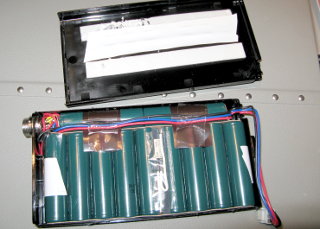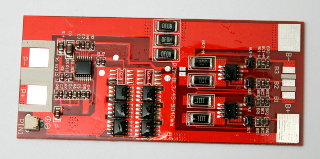
The following concerns lithium batteries, which can be
dangerous.
Do not try this at home. You will burn your house down,
kill your cat, and destroy your radio.
* WARNING! *
However, my irregular use of the NiMH batteries meant that their internal resistance was often quite high, as is often the case with NiMH batteries that are neglected. Even when new, the voltage dropped too much when transmitting at 20 W, so I generally stuck to 10 W. I even built a discharge circuit to condition the batteries now and then, but when the batteries finally died, I began investigating other options.

|
Here's an authentic FNB-78 battery pack cracked open. I would have liked to rebuild the pack with low-self-discharge NiMH batteries (such as the Sanyo Eneloop), which work exceptionally well in cameras, flashes, and the like, even with irregular use. They are not, however, available in the "4/3 A" format used in the FNB-78s and other similar NiMH battery packs. Other people have opted for sealed lead-acid (SLA) batteries, a.k.a. gel cells, which are cheap, and quite tolerant of any kind of use. Apparently some type of SLA fits quite snugly inside the FT-897. Their capacity, however, is significantly lower than that of the FNB-78. |

|
For safety, lithium battery packs always include some protection
circuit module (PCM)
or battery management system (BMS) which monitors
each cell separately and breaks the circuit, if any one of them is
charged too high or discharged too low. Either case might otherwise
destabilize the cell and shorten the battery pack's lifetime (at best)
or cause an explosion (at worst). Often it also limits the
total current to a safe level, and sometimes it contains circuitry to
balance the cells after charging. The
model PCM-LI14.8V10A
PCM I ordered
from BatterySpace.com
implements all these functions. For even more safety, I added an
8 A PolySwitch
overcurrent protector and a
72°C thermal
fuse in the circuit, and placed 1 A picofuses on the balancer
connections. The balancing function won't use that much current, but
if a soldered balancer wire should crack free from the PCM, the short
circuit won't destroy the battery.
Some PCMs don't have the balancer function built in. These can also be used, but then the batteries should be charged with a balancing charger. There was not much room in the FT-897's battery compartment for packaging the PCMs and other safety devices, so after soldering wires to them I simply covered them in heat-shrink tube. Even so, I was just barely able to fit the mess of wires and connectors in the limited space. If only I'd had the connectors available, I could have shortened the power leads on the batteries, instead of having to fold them over each other in the cramped space.
|

|
Since my PCM contains the balancer function (which is vital
with multi-cell lithium packs in the long run), I installed a pair of
two-pole Molex connectors on the back of the radio as charge
connectors. (If the PCM does not contain a balancer, a balancer
connector would also be needed, and a balancing charger should be
used instead.)
The radio has male 3-pole JST VH headers with 3.96 mm pitch for the internal batteries, so you need the corresponding female connectors. Not many electronics stores seem to have them, but they may be found on eBay (search for e.g. "JST VH 3p 3.96"). If you can't obtain the connectors anywhere else, cut them from old FNB-78s (that's what I did), or improvise. Here's one 2+2 cell battery and its safety circuits under test. Interestingly, with all connections made to the PCM, the output connector did not provide any voltage, almost like the PCM were faulty. It turns out that the batteries need to be charged, if only for a second, with the PCM in place. That "woke up" the PCM, and the battery pack became operational. I don't know if this is a deliberate feature of the PCM, or just a quirk of how the overdischarge protection is implemented. It could be either one. Here is the circuit diagram. It replaces a single FNB-78 battery pack. You can build two inside the FT-897. |
While lithium batteries don't self-discharge (not much, anyway), they don't like being stored long times at full charge. I wouldn't worry too much about that, but it's best to discharge them to approximately 40% charge (some 15 V or so) if they won't be used at all, say, during the winter months. The Bantam charger has a special "storage charge" function that charges or discharges the cells to a suitable voltage for long-term storage. Or the cells can first be charged full, and then discharged by leaving the radio on, until its voltage indicator shows 15 V.
The LiPos were quite expensive. Much more expensive than Yaesu's FNB-78 battery packs. But I think the investment was worth it. So how long will the batteries last, then? How many years, how many discharge cycles? I have no idea. The batteries are rated for a maximum output current of 165 A (yes, really, one hundred and sixty-five amps), whereas I will only ever draw some 5 A or so. Hopefully the light use will prolong their lifetime. In any case, battery failure usually comes in the form of gradually increasing internal resistance. In this relatively low current use, I can tolerate a bit of internal resistance. But only time will tell.
During two summers of use, I have encountered only one problem: Once, when transmitting an AM carrier (admittedly at unnecessarily high power) into a tuner after switching bands (resulting in high SWR at the transmitter), the entire battery suddenly died. The protection circuit had kicked in and disconnected the cells. There was still plenty of charge left in the cells, but the unusual RF conditions tripped the low-voltage safety circuit. Applying a charger very brifly reset the safety circuit. Unfortunately, I did not have a charger with me out in the field, so I was stuck with only one working battery. I think I will build a "dummy charger" out of two 9-volt batteries and a resistor, so I can reset the low-voltage cut-out if it happens again.
UPDATE: Fail!
The expensive LiPo batteries puffed up (damn, I forgot to take a
photo) after just over one year of use (actually one and a half summers),
so I returned them to the
dealer. The manufacturer accepted that the batteries were probably at
fault, and offered a quite reasonable compensation, despite the
warranty already having ended. Similar 6.6 A batteries were not,
however, available at the time, so I started looking into other
alternatives. I finally gave up on internal batteries, and built
an external NiMH battery pack instead.
One interesting alternative I've seen on the Net is making a new bottom plate for the radio, with its edges bent upwards, so there's more room for C or D -size batteries in the battery compartment. Some manufacturers (for example Ansmann Max-E; but no Sanyo Eneloop, for some reason) make low-self-discharge NiMH batteries in C-format, which provides some serious capacity. If physical size is not a primary issue, one might even go D-format. But since I eventually decided to go for an external pack, I'm now wondering if I could fit my LDG Z-100Plus Autotuner inside the empty battery compartment in some sensible way—that might be quite convenient also...
The batteries should not be dropped, banged, bent etc., they must never be charged to over 4.2 V/cell, nor should they ever be discharged below 2.5 V/cell, and their current ratings (which are different for charge and discharge) must be obeyed. There are many reported cases of Li-ion or LiPo packs exploding. And when you notice them starting to puff up, like mine did, it's best to cease using them before something bad happens.
Of course, LiPos should only be charged with a dedicated LiPo charger. Also, LiPos (or any other batteries, really) should never be charged unsupervised! Read more about lithium batteries at Battery University. And if you choose to try this yourself, you do so at your own risk. (Oh, and if you can't explain without googling, how many mAh will a 1 amp device consume in two hours, then please don't get involved in any DIY project that has rechargeable batteries in it!)
You have been warned.